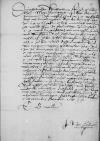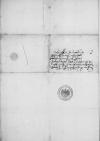 GStA, PK, HBA, C 2, No 36, f. 2v
GStA, PK, HBA, C 2, No 36, f. 2v
Dem durchlaucht(e)n, hochgeborn(n) furst(e)n und h(e)rn, h(e)rn ⌊Albrecht(e)n⌋, von(n) Gots gnad(en) margraff(en) zu ⌊Branden burg⌋ etc. herczogen(n)[1] in ⌊Preussenn(n)⌋ etc. meym(m) g(nedigen), lib(e)n h(e)rn
Im negst(e)n hab ich E(wer) G(naden) ⌊⌋, das ich durch meynen(n) bruder, / den ich hie zu E(wer) G(naden) geschickt, / etliche muntliche werbunge wolde thun / in freuntlicher zuvorsicht, E(wer) G(naden) werd die guttlich von mir uff nhemen(n) und vorsthen(n) / und sich dar innen(n), wie meyn(n) g(nediger), liber her(r) beweisen(n), / derhalben(n) ich E(wer) G(naden) bit, wolt dissen(n) meynen(n) bruder von meynen wegen(n) guttlich vorhören(n) / und im in dem(m), / was her in meynem(m) nhamen(n) E(wer) G(naden) wirt anczeigen(n), / nicht anders als mir selbst glouben(n) geben(n) / und was her E(wer) G(naden) und derselbtig(en) ⌊furstynnen(n)⌋ / kleyn(n), geringe werck von(n) meynen(n) wegen(n) wirt vor ehren(n) / freuntlich und gunstlich uff nhomen(n) und nicht das gegeben(n), / sunder meyn(n) dinstlich gemut und willen(n) ermessen(n), / do neben(n) ouch meyn(n) svoger, den(n) h(e)rn ⌊doctor⌋, E(wer) G(naden) diner, / befholen(n) haben(n) / und meyn(n) g(nediger), lib(e)r her(r) seyn(n) und bleib(e)n. / Got der almechtige enthalde E(wer) G(naden) in langweriger gesuntheit und glukseligem(m) zunhemen(n) lange zceit. /
Dat(um) uffm(m) sloss ⌊Lobau⌋, 7 Decembr(is) an(n)o d(omi)ni 1532.
E(wer) G(naden) willig(er)
⌊Jo(annes)⌋, b(ischoff) zu ⌊Culmen(n)⌋ ma(nu) p(ro)pria
 GStA, PK, HBA, C 2, No 36, f. 2v
GStA, PK, HBA, C 2, No 36, f. 2v  GStA, PK, HBA, C 2, No 36, f. 1r
GStA, PK, HBA, C 2, No 36, f. 1r 
